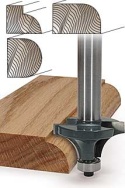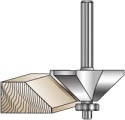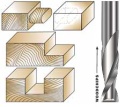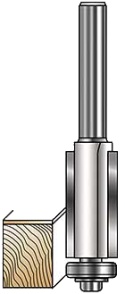Hi David,
I recently wrote a small article on this topic. This is just my opinion for what I have found to be the primary bits I think every beginner should have:
Here's an exerpt from the article:
I believe the router table is one of the most useful and versatile tools in the shop. There's no other machine that can do so many different operations. The wide variety and vast selection of router bits available today makes it even easier to do more with your router.
Beginning woodworkers often opt to buy a router bit set that contains a plethora of various carbide nuggets. It's true that you certainly get more bits for the money when you buy a router bit set, but is it really a better value? The reason it might not be a better value is due to the fact that you probably won't regularly use a majority of the bits in the set.
I put together a list of four must-have bits for any woodworker that uses a router. This list works nicely for the beginning woodworker as an alternative to buying a bit set. It may be a shock at first to spend $20 to $50 or more on a decent single bit, but when you get a lot of use (and longevity) out of that bit, the price becomes justified.
If you're interested in which specialty bits I use, check out
this article.
 Roundover Bit
Roundover Bit
A small roundover bit is a nice way to "knock off" the sharp edge of a board. Using a roundover bit will ensure a consistent rounded edge along the length of the board. Roundover bits come in different sizes to produce a different sized radius on the board's edge.
I recommend getting a small one and a medium size one (1/4 roundover and 1/2 inch roundover would be good). Larger roundover bit can be used to create a bullnose (1/2 round on the edge of a board, like a stair tread).
 Chamfer Bit
Chamfer Bit
Ideal for beveling and decorative edges, and can also be used for for producing a 45° edges for mitres. The chamfer bit is also a nice way to "knock off" the sharp edge of a board. It's common to see chamfered edges or ends on Arts and Crafts furniture.
The nice thing about a chamfer bit is that unlike a round over bit that produces a certain radius, a chamfer bit is just an angled bevel, so you can buy a fairly big bit and always cut a small chamfer with it.
 Solid carbide spiral upcut bit
Solid carbide spiral upcut bit
The solid carbide spiral upcut bit is a versatile bit that can be used for rabbits, dados, tenons & mortising.
There's a lot of straight cutting bits to choose from. If you have a plain old straight fluted cutting bit, you really need to try a spiral bit. The solid carbide spiral bits costs more, but are well worth the extra in my opinion - the cut faster, eject chips better, and last longer.
 Bearing guided flush trim bit
Bearing guided flush trim bit
For use in trimming laminates and pattern routing. 1/2 inch diameter by 1.5 or 2 inch length is good
Pattern routing is a technique that copies a pattern that is the exact size as your final piece by using a flush cut bit to trim your workpiece flush with the pattern. The workpiece is first roughed to a size slightly larger than the final dimensions, and then the pattern is stuck to the workpiece with double sided tape during the routing operation. The bearing rides along the pattern and trims the workpiece flush with the pattern.
A pattern bit can also be used to easily trim veneer or laminate even with its substrate. The veneer or laminate is purposely left oversized and then trimmed flush using a bearing guided flush trim bit.
Specialty varieties of this bit include a solid carbide spiral version, or a bit with the bearing located above, below or both above and below the cutter.
The original article can be found here:
http://www.eaglelakewoodworking.com/post/What-Router-Bits-Should-a-Beginning-Woodworker-Buy-First.aspx



 Reply With Quote
Reply With Quote



 .
.







